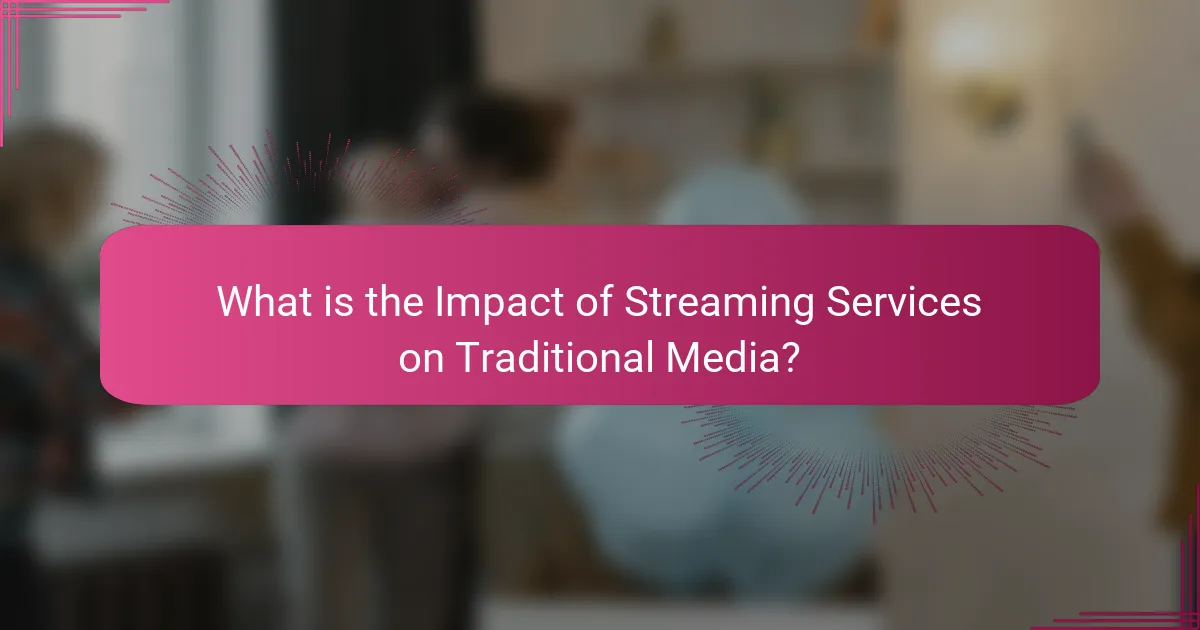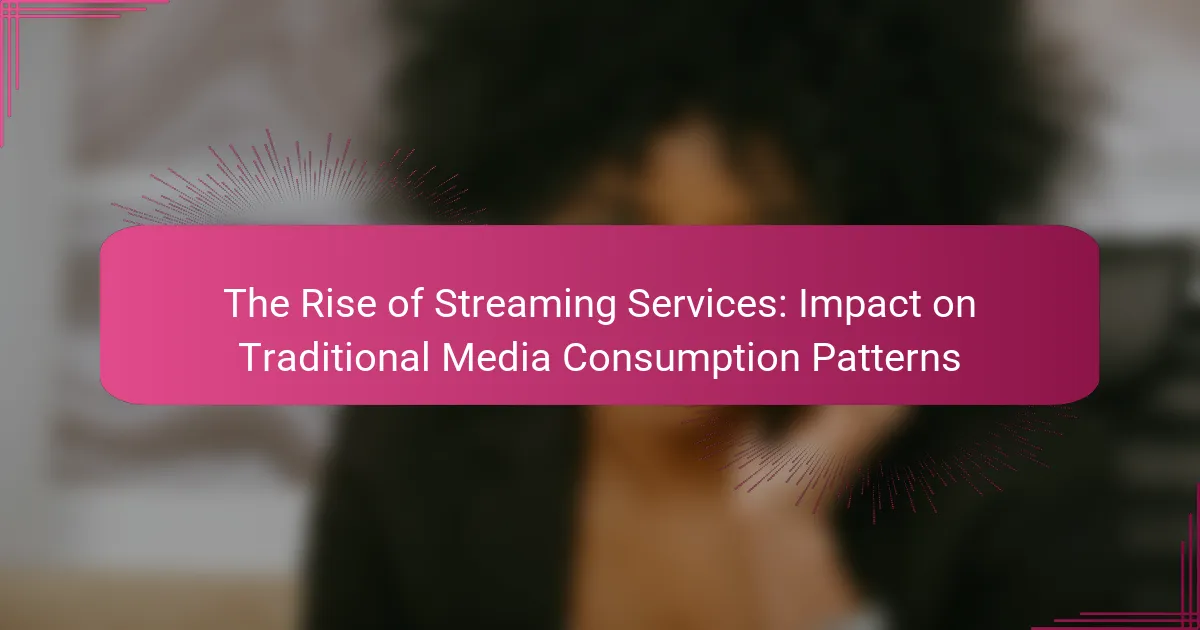Streaming services are digital platforms that provide on-demand access to movies, TV shows, music, and other media via the internet. Since their emergence in the early 2000s, particularly with Netflix’s launch of streaming in 2007, these services have transformed consumer engagement with media, leading to a decline in traditional cable TV viewership. By 2021, over 80% of U.S. households subscribed to streaming platforms, which offer diverse content libraries and personalized viewing experiences. The article explores how streaming services disrupt traditional media consumption patterns, the shift in advertising budgets, and future trends such as increased personalization, user-generated content, and the integration of augmented and virtual reality for enhanced viewer engagement.

What are Streaming Services and Their Emergence?
Streaming services are platforms that deliver content via the internet. They allow users to access movies, TV shows, music, and other media on demand. The emergence of streaming services began in the early 2000s. Netflix was one of the first companies to offer streaming in 2007. This shift changed how consumers engage with media. Traditional media consumption patterns, like cable TV, declined as streaming gained popularity. By 2021, over 80% of U.S. households had access to streaming services. The convenience and variety offered by streaming services are key factors in their rapid growth.
How have streaming services transformed media consumption?
Streaming services have transformed media consumption by providing on-demand access to a vast array of content. Users can now watch shows and movies at their convenience, without being tied to scheduled broadcasts. This shift has led to the decline of traditional cable subscriptions. According to a report by Nielsen, streaming accounted for over 30% of total TV viewing time in 2021. Additionally, streaming platforms often produce original content, changing the landscape of media production. The rise of binge-watching has also altered viewing habits, with many viewers consuming entire seasons in one sitting. Overall, streaming services have made media consumption more flexible and personalized.
What are the key features of streaming services?
Streaming services offer on-demand access to a wide variety of content. Users can watch movies, TV shows, and documentaries anytime. These platforms typically feature subscription-based models for access. Many services allow offline viewing by downloading content. High-definition streaming is a common attribute, providing better visual quality. Personalization through algorithms recommends content based on viewing habits. Multi-device compatibility enables viewing on smartphones, tablets, and smart TVs. Exclusive original programming is a significant draw for many streaming platforms.
How do streaming services differ from traditional media?
Streaming services differ from traditional media in their delivery and consumption methods. Streaming services provide on-demand access to content via the internet. Traditional media, such as television and radio, often follow scheduled programming. Users of streaming services can watch or listen to content anytime and anywhere with an internet connection. In contrast, traditional media typically requires users to adhere to specific broadcasting times.
Additionally, streaming services often offer a broader selection of content. They include original programming and user-generated content. Traditional media usually relies on a limited number of channels and shows. Subscription models frequently characterize streaming services, allowing users to pay for access. Traditional media often depends on advertising revenue and cable subscriptions.
The flexibility and variety of streaming services have led to significant changes in consumer habits. According to a report by Nielsen, streaming has surpassed cable TV in viewership among younger demographics. This shift highlights the growing preference for on-demand content over traditional scheduling.
Why have streaming services gained popularity?
Streaming services have gained popularity due to their convenience and accessibility. Users can watch content on-demand from various devices. This flexibility allows for personalized viewing experiences. Additionally, streaming services often provide a diverse library of content. This includes original programming not available on traditional media. The subscription-based model offers ad-free viewing options. As of 2023, over 300 million people in the U.S. subscribe to streaming services. This trend reflects a significant shift in media consumption habits.
What demographic trends are influencing streaming service growth?
Younger demographics are significantly influencing streaming service growth. The 18-34 age group shows a strong preference for on-demand content. This group values flexibility and accessibility in their viewing habits. Additionally, the increasing use of mobile devices for streaming is notable. According to a report by eMarketer, 67% of 18-29-year-olds watch streaming services regularly. Furthermore, diverse content options cater to varied cultural backgrounds. This trend attracts a broader audience, enhancing subscription rates. Lastly, the shift from traditional cable to streaming is evident across age groups, with younger viewers leading this change.
How do user preferences shape the success of streaming platforms?
User preferences significantly shape the success of streaming platforms. These platforms analyze viewing habits to tailor content offerings. Personalized recommendations enhance user engagement and satisfaction. For instance, Netflix uses algorithms to suggest shows based on past viewing. A report by Deloitte found that 80% of viewers prefer personalized content. User feedback influences platform features and interface design. Streaming services that adapt to user tastes tend to retain subscribers longer. Additionally, exclusive content often attracts specific demographics. Overall, aligning with user preferences is crucial for competitive advantage in the streaming market.

What is the Impact of Streaming Services on Traditional Media?
Streaming services significantly disrupt traditional media. They offer on-demand content, which contrasts with scheduled programming. This shift leads to declining viewership for cable and broadcast television. In 2021, cable TV lost approximately 6 million subscribers in the U.S. Streaming platforms provide diverse content libraries. This variety attracts audiences seeking personalized viewing experiences. Traditional media struggles to compete with the convenience of streaming. Advertisers are shifting budgets from traditional media to digital platforms. This trend reflects changing consumer preferences towards instant access.
How have viewing habits changed due to streaming services?
Viewing habits have significantly changed due to streaming services. Audiences now prefer on-demand content over scheduled programming. Streaming platforms offer vast libraries of shows and movies accessible anytime. This shift has led to a decline in traditional cable subscriptions. According to a 2021 report by Nielsen, 82% of U.S. households subscribe to at least one streaming service. Binge-watching has become a common practice, with viewers consuming entire seasons in one sitting. Additionally, mobile viewing has increased, with many people watching content on smartphones and tablets. Overall, streaming services have reshaped how and when people consume media.
What are the statistics on traditional media consumption decline?
Traditional media consumption has significantly declined over the past decade. According to a 2021 report by Nielsen, television viewership dropped by 10% in 2020 compared to the previous year. Additionally, print newspaper circulation has decreased by 50% since 2004, as reported by the Pew Research Center in 2020. Radio listenership has also seen a decline, with a 5% drop in 2021, according to Edison Research. Streaming services have gained popularity, with over 80% of U.S. households subscribing to at least one streaming service by 2022. These statistics illustrate a clear shift away from traditional media toward digital platforms.
How has audience engagement shifted with the rise of streaming?
Audience engagement has shifted significantly with the rise of streaming services. Viewers now prefer on-demand content over scheduled programming. Streaming allows for binge-watching, increasing time spent on platforms. According to a Nielsen report, streaming accounted for 34% of total TV viewing time in 2022. This shift has diminished traditional TV ratings and live viewership. Social media interaction has also increased, as audiences discuss content in real-time. Streaming platforms often provide personalized recommendations, enhancing user engagement. Overall, streaming has transformed how audiences consume and interact with media content.
What challenges do traditional media face in adapting?
Traditional media faces significant challenges in adapting to the rise of streaming services. One major challenge is the shift in consumer preferences towards on-demand content. Viewers increasingly favor the flexibility and convenience that streaming platforms offer. Traditional media struggles to compete with the vast content libraries available on these platforms. Additionally, advertising revenue has declined as advertisers shift their budgets to digital media. Traditional media also grapples with the need to innovate and implement new technologies. The rapid pace of change in viewer habits complicates long-term strategic planning. Furthermore, the competition from both established and emerging streaming services intensifies the pressure on traditional media outlets.
How are traditional media companies responding to streaming competition?
Traditional media companies are adapting to streaming competition by launching their own streaming services. Companies like Disney and Warner Bros. have created platforms such as Disney+ and HBO Max. They aim to retain audiences who are shifting away from traditional cable. Additionally, traditional media is investing in original content to attract subscribers. This includes exclusive shows and films that can only be found on their platforms. Partnerships and mergers with tech companies are also common. These collaborations enhance distribution and technology capabilities. Traditional media companies are also embracing digital advertising strategies to monetize their content effectively. Overall, the response is multifaceted, focusing on innovation and audience retention.
What strategies are being implemented to retain viewers?
Streaming services are implementing personalized content recommendations to retain viewers. These algorithms analyze user behavior and preferences. By offering tailored suggestions, platforms increase viewer engagement. Interactive features, such as live chats and polls, also enhance user experience. Exclusive content and original programming attract and keep subscribers. Flexible subscription models provide options for consumers, improving retention. Data from a 2021 report by Deloitte shows that 61% of viewers prefer personalized experiences. These strategies collectively contribute to higher viewer loyalty and satisfaction.

What Future Trends Can We Expect in Media Consumption?
Future trends in media consumption include increased personalization and interactivity. Streaming services are leading this shift by utilizing algorithms to tailor content to individual preferences. This trend is supported by data showing that 80% of viewers prefer personalized recommendations. Additionally, user-generated content is becoming more prominent. Platforms like TikTok and YouTube allow users to create and share their own media. This shift indicates a move towards participatory media experiences. Furthermore, mobile consumption is on the rise. Research indicates that 70% of video content is now consumed on mobile devices. This trend emphasizes the need for media to be accessible on various platforms. Lastly, the integration of augmented and virtual reality is expected to enhance viewer engagement. These technologies can create immersive experiences that traditional media cannot provide.
How will technology influence the evolution of streaming services?
Technology will significantly influence the evolution of streaming services through advancements in bandwidth and artificial intelligence. Increased bandwidth enables higher quality streaming, such as 4K and 8K resolutions. This improvement enhances user experience and attracts more subscribers. Artificial intelligence personalizes content recommendations, improving viewer engagement. For instance, Netflix uses AI algorithms to suggest shows based on user preferences. Additionally, cloud computing allows for scalable storage and delivery of vast content libraries. This scalability supports the growing demand for diverse programming. Moreover, innovations in mobile technology facilitate on-the-go streaming, expanding audience reach. These technological advancements shape the future landscape of streaming services, driving competition and content diversity.
What role do advancements in internet infrastructure play?
Advancements in internet infrastructure enable faster and more reliable access to streaming services. Improved bandwidth allows users to stream high-definition content without buffering. This reliability increases user satisfaction and encourages more frequent use of streaming platforms. Enhanced infrastructure supports a growing number of connected devices in households. According to a report by Cisco, global IP traffic will reach 4.8 zettabytes per year by 2022. This exponential growth in data consumption reflects the demand for streaming services. Additionally, advancements facilitate innovations such as 5G technology, which significantly reduces latency. Lower latency enhances real-time interactions in streaming, making it more appealing to consumers.
How might artificial intelligence change content delivery?
Artificial intelligence will significantly change content delivery by personalizing user experiences. AI algorithms analyze user data to recommend tailored content. This leads to increased engagement and satisfaction. For example, streaming platforms like Netflix use AI to suggest shows based on viewing history. Additionally, AI can optimize content distribution timing for maximum audience reach. It can also automate content creation, allowing for rapid production of videos and articles. A report by McKinsey notes that AI-driven personalization can increase customer retention by up to 30%. Overall, AI is transforming how content is curated, delivered, and consumed.
What can traditional media learn from streaming services?
Traditional media can learn about audience engagement strategies from streaming services. Streaming platforms utilize personalized content recommendations to retain viewer interest. They analyze user data to tailor suggestions based on viewing habits. This data-driven approach increases user satisfaction and loyalty. Furthermore, streaming services often release entire seasons at once. This binge-watching model encourages sustained viewer engagement. Traditional media can adopt similar strategies to enhance viewer retention. By embracing flexibility in content delivery, traditional media can better compete in the evolving landscape.
How can traditional media innovate to stay relevant?
Traditional media can innovate to stay relevant by adopting digital platforms and enhancing audience engagement. This includes creating multimedia content that resonates with users on social media. Research shows that 70% of consumers prefer video content over text. Traditional media can also leverage data analytics to tailor content to specific audience preferences. Additionally, partnerships with streaming services can broaden reach and diversify offerings. For instance, NBCUniversal’s Peacock integrates traditional shows with new streaming content. Such strategies can help traditional media attract younger demographics who favor on-demand viewing.
What best practices can be adopted from streaming service models?
Best practices from streaming service models include personalized content recommendations, subscription-based pricing, and user-friendly interfaces. Personalized recommendations enhance user engagement. Services like Netflix utilize algorithms to suggest content based on viewing history. Subscription-based pricing offers predictable revenue streams. This model has proven successful, with Netflix reaching over 230 million subscribers in 2023. User-friendly interfaces improve accessibility and retention. Simple navigation encourages longer viewing times. Implementing these practices can significantly enhance user experience and loyalty.
What are the key takeaways for consumers in this changing landscape?
Consumers must adapt to the increasing prevalence of streaming services over traditional media. Streaming platforms offer flexibility in viewing schedules. They often provide a wider range of content options. Consumers can access shows and movies without geographic restrictions. Subscription costs can be lower than traditional cable packages. This shift encourages personalized viewing experiences. Viewers should consider bundling services to maximize value. Staying informed about new services and content is essential for making the best choices.
The main entity of the article is streaming services, which are platforms that provide on-demand access to a variety of media content via the internet. The article outlines the emergence and growth of streaming services, highlighting their impact on traditional media consumption patterns, including the decline of cable TV and changes in viewer habits such as binge-watching and preference for personalized content. Key features of streaming services, demographic trends influencing their popularity, and the challenges faced by traditional media in adapting to these changes are also discussed. Additionally, the article explores future trends in media consumption, technological advancements, and best practices that traditional media can adopt to remain relevant in this evolving landscape.
